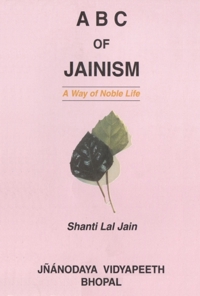LESSON 2
Twenty Four Tīrthankaras
Tīrthankaras are famous noble personalities. They are great preachers of the religious order. They take birth from their parents like any other person and they follow the Right Path to achieve salvation.
Tīrthankaras, in their previous lives continuously think and muse all the time for the welfare of all. As a result of this, they attain this status. They have five celebrations in their lives. These are: Garbha Kalyānaka (Celebration of Conception), Janma-Kalyānaka (Celebration of birth), Dikṣa-Kalyānaka (Celebration of attaining monk-hood), Jñāna Kalyānaka (Celebration of attaining perfect knowledge) and Mokṣa Kalyānaka (Celebration of attaining salvation).
Such celebrations are known as PAÑCA-KALYĀNAKA.
After attaining Perfect Knowledge, Tīrthankaras deliver sermons for the well being of all. They preach universal love, compassion and harmony; that is the nature of all souls. Their sermon is phonetic like sweet music. This is known as DIVYA-DHVANI, which gives clear and correct understanding to all. The pavilion for delivering the sermon is known as SAMAVASARANA. In this pavilion, all living beings get equal opportunity to listen the preachings. All celestials, animals and human beings assemble at the same time and enjoy the preachings with perfect harmony. They forget their natural inherent hostile instincts. This is the influence of Tīrthankara.
According to Jainism, there are infinite souls who have attained the status of salvation. But in every fourth era of time, only twenty-four pure souls attain the status of Tīrthankaras in India (Bharata Kṣetra). Each Tīrthankara's idol (Jina-Bimba) has an emblem (Cinha). The emblem is given on the basis of the mark noticed on the thumb of the right foot of the Tīrthankara at the time of birth. Here, we give the names and emblems of the present twenty-four Tīrthankaras.
In the Jaina temples (Jinalayas), idols of Tīrthankaras are worshipped daily by all Jainas. By reciting their virtues, we get peace, purity of thoughts and happiness.
# | TĪRTHANKARAS | Emblems (Cihna) |
01. | Ṛṣabha-nātha or Ādi-nātha | Bullock (Vrasabha) |
02. | Ajita-nātha | Elephant (HATHĪ)· |
03. | SamBhāva-nātha | Horse (GHOḌA) |
04. | Abhinandan-nātha | Monkey (BANDARA) |
05. | Sumati-nātha | Curlew (CAKAVA) |
06. | Padma-prabha | Red lotus (LĀLA-KAMALA) |
07. | Suparśva-nātha | Svastic (SVĀSTIKA) |
08. | Chandra-prabha | Crescent (CANDRAMA) |
09. | Puspadanta or Suvidhi-nātha | Crocodile (MAGARA) |
10. | Śītata-nātha | Wish yielding tree (KALPA VṚKŚA |
11. | Śreyāmsa-nātha | Rhinoceros (GENDĀ) |
12. | Vāsupoojya | Buffalo (BHAINSA) |
13. | Vimala-nātha | Pig (ŚŪKARA) |
14. | Ananta-nātha | Porcupine (SEHĪ) |
15. | Dharrna-nātha | Thunderbolt (VAJRA-DANDA) |
16. | Śānti-nātha | Deer (HIRANA) |
17. | Kunthu-nātha | He-goat (BAKARĀ) |
18. | Araha-nātha | Fish (MACHALĪ) |
19. | Malli-nātha | Water-pot (KĀLAŚA) |
20. | Munī-suvratanātha | Tortoise (KACHUA) |
21. | Nami-nātha | Blue lotus (NĪL-KAMALA) |
22. | Nemi-nātha | Conch shell (SANKHA) |
23. | Parśva-nātha | Serpent (SARPA) |
24. | Mahāvīra-svāmī | Lion (SIṄHA) |
The series of Tīrthankaras, in the present age begin with Ṛṣabhadeva, the first Tīrthankara. Bhagavān Mahāvīra is the last Tīrthankara. Thus, we are enjoying the Tīrtha or religious order of Bhagavāna Mahāvīra.
It may be mentioned that the five Tīrthankaras, namely Ṛṣabhadeva or Ādi-Nātha. Ajita-Nātha, Abninandana-Nātha, sumau-Nātha and Ananta-Nātha were born in Ayodhyā. The rest of Tīrthankaras were born in different parts of Bharata-Kṣetra.
Ṛṣabhadeva attained Nirvāṇa at Mount Kailaśa in Tibet, Vasupujya at carnpapura in Bihar, Nerni-Nātha at Mount Giranara in Gujrat and Mahāvīra at Pavapura in Bihar. The rest twenty Tīrthankaras attained Nirvāṇa at Mount Sammed-Sikhara in Bihar.
We pray to Bhagavāna Mahāvīra and other Tīrthankaras to learn the teachings of self-help and non-violence; and learn how to attain real happiness and peace.
Five Tīrthankaras namely, Vāsupūjya, Malli-Nātha, Nemi-Nātha (Ariṣṭa-Nemī), Parśva-Nātha and Mahāvīra did not marry.
Glossary:
Harmony : Agreement of feeling
Muse
: To think deeply.
Celestials
: Heavenly; divine.
Sermon
: Speech on religious or moral subjects.
Hostile
: Unfriendly
 Shanti Lal Jain
Shanti Lal Jain
